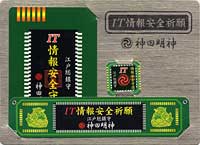|
|
|||||||
|
|
|||||||
|
|||||||
| | Web Japan >> | Trends in Japan >> | Lifestyle >> | Lucky Charms for the Twenty-First Century | |
|
LUCKY CHARMS FOR THE TWENTY-FIRST CENTURY O-mamori Adapt to Modern Times (March 15, 2005) Every New Year's holiday, millions of Japanese head to shrines or temples to pray for good fortune for the coming year. For most, the ritual is more of a seasonal custom than an expression of religious devotion. Even so, the shrine visits would not be complete without the purchase of a good-luck charm, called o-mamori in Japanese. These small objects, usually contained within a beautifully decorated fabric bag and bearing inscriptions, are said to protect their owners against all sorts of bad fortune. Charms to Protect Against Every Misfortune As the number and variety of people's anxieties have grown during the modern age, so have the number and range of charms available. In the last few years, new types of charms have appeared to reflect some very twenty-first century concerns - charms to ward off computer or cellphone glitches, for example. Shrine visits - and the opportunity to pick up an o-mamori - are not limited to the New Year period. In line with the old saying, "Pray to the gods in times of trouble," many Japanese visit shrines with the aim of assuaging their worries or to wish for something that the mortal world is not providing. School and university exams are a prime example. Every year from January to March, students sit down to take examinations to determine what school or university they will be able to enter. It is a busy period for Japan's shrines, many of which are visited not only by the students themselves but also by their anxious families, especially mothers. It is also a time when o-mamori sell like hot cakes. Some people visit large numbers of different shrines, buying up charms at every opportunity in the belief that the more lucky charms they have in their possession, the better their luck will be. This strategy makes sense, given the large number of gods in Japanese religion and the vast range of requests they are said to respond to. Even so, selecting which charms to buy is a task that requires a certain degree of caution. Some gods do not get on with one another, and possessing charms from two such gods may result in their canceling each other out. Shrines Start to Innovate Good luck charms of all types have proved to be big moneymakers for the shrines that sell them. Many people deposit their old charms at the shrines, where they are burned, and buy replacements. The more people replace their charms like this, the more revenue the shrines can earn. This has motivated many shrines to be innovative when it comes to producing their o-mamori. The Tozan Shrine, for instance, is located in the birthplace of the famous Aritayaki style of pottery in Saga Prefecture. Its charms, called Aritayaki My O-mamori, are made from the renowned porcelain and bear the names of their owners written by the shrine's chief priests. They cost ¥400 ($3.80 at ¥105 to the dollar) and can be mailed to customers for an extra ¥80 (about 80¢). Lucky Locations Some o-mamori have strictly practical purposes. One type, consisting of a bag containing a charm and a small electronic device, uses satellite communication technology to pinpoint the location of the purchasers' children. The Ichigaya Kameoka Hachimangu shrine in Tokyo collaborated with Secom Co., a security company, to produce this system. It works in conjunction with cellphones and personal computers to determine and then report the location of the child carrying the charm, which is indicated on a screen. Subscribers pay an initial fee of ¥5,000 ($47) and then ¥500 ($4.70) monthly. Though borne of an ancient age, o-mamori clearly continue to have an impact on the lives of Japanese people today. Whether ushering in a new year, preparing to take an important exam, or hoping to protect one's family, pets, or possessions from harm, there are lucky charms to suit every concern and wish - however modern. Copyright (c) 2005 Web Japan. Edited by Japan Echo Inc. based on domestic Japanese news sources. Articles presented here are offered for reference purposes and do not necessarily represent the policy or views of the Japanese Government. |
BEATING STRESS WITH MEDITATION (June 24, 2003) JAPANESE STYLE IS IN (April 24, 2002) |
|
|



